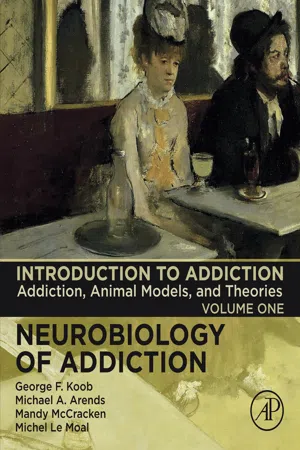
Introduction to Addiction
Addiction, Animal Models, and Theories
- 278 pages
- English
- ePUB (mobile friendly)
- Available on iOS & Android
Introduction to Addiction
Addiction, Animal Models, and Theories
About this book
Introduction to Addiction, Volume One in the series, introduces the reader to the study of neurobiology of addiction by clearly defining addiction and its neuroadaptational views. This volume includes thorough descriptions of the various animal models applicable to the study of addiction, including Animal Models of the Binge-Intoxication Stage of the Addiction Cycle and Animal Models of Vulnerability to Addiction. The book's authors also include a section on numerous neurobiological theories that aid in the understanding of addiction, including dopamine, prefrontal cortex and relapse.- Provides neurobiological theories on how addiction works- Explains addiction cycle stages of binge, withdrawal and anticipation- Reviews the role of dopamine and the frontal cortex in addiction- Discusses the neurocircuitry of reward and stress- Includes animal models and neuroadaptational views on addiction
Frequently asked questions
- Essential is ideal for learners and professionals who enjoy exploring a wide range of subjects. Access the Essential Library with 800,000+ trusted titles and best-sellers across business, personal growth, and the humanities. Includes unlimited reading time and Standard Read Aloud voice.
- Complete: Perfect for advanced learners and researchers needing full, unrestricted access. Unlock 1.4M+ books across hundreds of subjects, including academic and specialized titles. The Complete Plan also includes advanced features like Premium Read Aloud and Research Assistant.
Please note we cannot support devices running on iOS 13 and Android 7 or earlier. Learn more about using the app.
Information
What is addiction?
Abstract
Keywords
1. Definitions of addiction
1.1. Drug use, drug abuse, and drug addiction
1.2. Diagnostic criteria for addiction
| DSM-5 | DSM-IV | ICD-10 |
|---|---|---|
| Dependence | ||
| A problematic pattern of substance use leading to clinically significant impairment or distress, as manifested by at least two of the following occurring within a 12 month period: | A maladaptive pattern of substance use, leading to clinically significant impairment or distress as manifested by three or more of the following occurring at any time in the same 12-month period: | Three or more of the following have been experienced or exhibited at some time during the previous year: |
| 1. Tolerance is defined by either of ... | ||
Table of contents
- Cover image
- Title page
- Table of Contents
- Copyright
- Volumes in the series
- Preface
- Chapter 1. What is addiction?
- Chapter 2. Animal models of addiction
- Chapter 3. Neurobiological theories of addiction
- Index